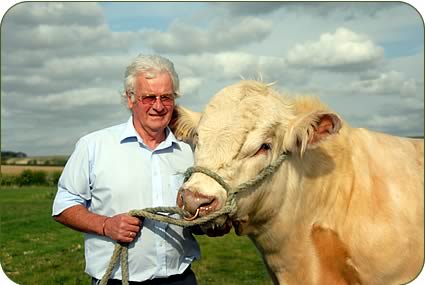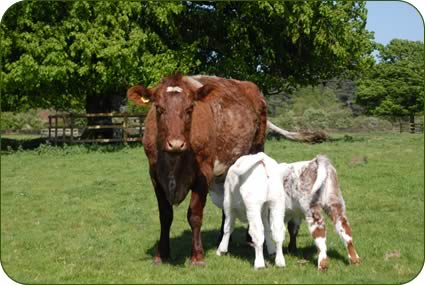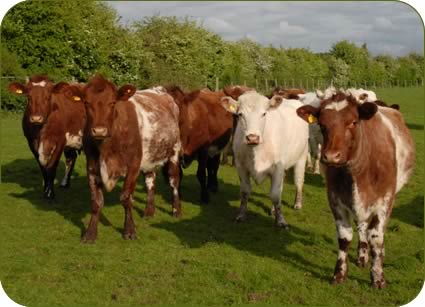Jennifer MacKenzie is an agricultural photo journalist with almost 30 year's experience. Operating from her base in Cumbria, Jennifer undertakes mainly industry-related freelance writing and photography.
Glenariff Beef Shorthorns
Norfolk cattleman Nick Barrett runs 150 head of pedigree Beef Shorthorns – yet
he has no farm and only owns 30 acres of land.
Such is his dedication that he can travel up to 45 miles in a day checking
his stock on the hired land scattered around his home Glenariff, named
after a picturesque valley in Northern Ireland, at South Wootton near Kings
Lynn, up to 200 acres of which is on the 28,000 acre royal estate of Sandringham.
Nick and his wife Annalain founded the Glenariff herd in 1989 with two
maiden heifers from Willie McGowan’s Fingask herd at Cupar, Fife
and two maiden heifers from Major John Gibbs’s Glenisla herd draft
sale in Perthshire.
Like their passion for breeding Gloster Fancy Canaries for which they have
world-wide acclaim, the Barretts bred their current herd now numbering
70 breeding females from those original foundation cows.
 |
| Nick Barrett and his bull Glenariff Alaska which is entered for the Carlisle sale on Friday (May 22) |
With no background in farming, Nick studied agriculture at Norfolk College
of Agriculture, specialising in farm animal husbandry and management.
From 1959 to 1976 he worked with dairy cows, beef cattle, sheep and breeding
pigs gaining a valuable all-round experience.
For the next 29 years until 2001 he worked as senior animal health inspector
for Norfolk County Council during which time he was involved with farm
animal welfare, advisory animal health law and tuition to farmers, local
government departments and the RSPCA.
So it is not surprising that their Shorthorn cattle, canaries and flock
of 45 Kerry Hill sheep all have a high health status.
“I had worked with cattle all my life although my family background
had nothing to do with farming,” said Nick.
“I knew the Beef Shorthorn was a native British breed with a longer
history than any other breed but I knew little else about them. I had seen
the cattle DJ and JM Taylor showed with great success – big, thick-set
heavy cows – and I liked them.”
When the Barretts set out with their herd they only intended to run half
a dozen cows and a bull, however, numbers have expanded to the current
herd size, spurred also by their son Andrew’s enthusiasm for livestock.
 |
| A Beef Shorthorn cow suckling her own calf and allowing another cow's calf to drink |
After gaining his National Diploma in agriculture at Kirkley Hall College
in Northumberland, Andrew gained experience from 12 months working in Australia
and New Zealand and he now runs a successful contracting business as well
as managing the Beef Shorthorn herd with his parents and his wife Danielle.
The main investment in the herd has been the purchase of breeding bulls.
Numbers have been built up from a total of eight purchased females with
the emphasis on buying families which have included Lancaster, Broadhooks,
Princess, Flossie, Rothes, Ruby, Katrina and Gina.
The herd’s first stock bull Chapelton Eagle by Uppermill Lang, left
his mark on the herd, siring the 2002 Royal Show female and reserve breed
champion Glenariff Lancaster Krystal out of Fingask Lancaster Petula. The
heifer Chapelton Princess joined the herd at the same time as Eagle.
 |
| Glenariff Yashin - one of three stock bulls |
The next stock bull, Uppermill Lister was bought in Perth as an over aged
bull for only 1,000gns and he was retired in 2008 at the age of 17. So
good was his progeny that a lot of the females in the herd today are by
him. In the show ring he was overall reserve champion at the Royal Show.
Chapelton Legend followed – although not big he was a very correct
bull and is the sire of current stock bull Glenariff Washington. He was
sold to Eddie Mills for his herd in Gloucestershire.
Uppermill Beggar brought stature to the herd and he had an illustrious
show record winning the Royal Welsh Show and the breed championship twice
at the Great Yorkshire Show before being sold on to pedigree breeder Peter
Kelly in County Carlow in the Republic of Ireland.
Current stock bulls are six year old Glenariff Washington by Chapelton
Legend, four year old Glenariff Yashin by Chapelton Tyco and three year
old Tofts Hector bought in Perth in February 2007 for 8,000gns.
“The huge selling point of the breed is its docility which is important
for us when there is just Andrew and myself looking after the cattle. Our
cattle outwinter and do well,” said Nick.
 |
| Glenariff females |
Not surprisingly, Nick puts the health of his animals as a priority. The
cattle are in the SAC health scheme and are vaccinated for BVD and tested
clear of other diseases. The herd is on a four year TB test.
The Barretts are also careful to handle their animals gently which further
enhances temperament and as an example Nick never pulls a bull by its ring.
Bulls are sold mainly privately from Cornwall to Caithness and in between
as well as into southern Ireland, mainly to pedigree breeders, and testament
to the quality and reliability of the bulls is that the buyers come back
for more. The bull Glenariff Alaska is entered for the Shorthorn Society
sale in Carlisle on May 22.
“We try to be sensible about the price as we want to encourage as
many people both pedigree and commercial breeders to use the Shorthorn.
We always follow up to see how our bulls are doing,” said Nick.
Fertility in the Glenariff herd is high. Heifers are calved at 30 months
old in August and September and then they are brought back in line with
the rest of the herd which calves from March onwards.
The cattle are fed a basic diet in the winter of hay, straw and feed blocks
with some concentrate with minerals and trace elements. Potale syrup has
been used this winter.
“If you feed breeding stock too well there is a price to pay for
it. The bulls to be sold are well-fed but we don’t want excess body
condition which then puts them off their feet and be too heavy to serve
the cows. Fat covers a multitude of sins,” said Nick.

